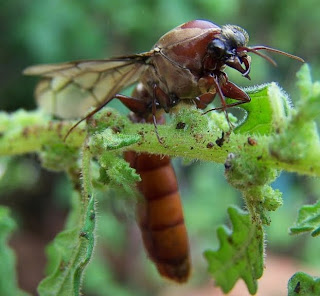 This is male and although vicious looking, they are harmless to humans.
This is male and although vicious looking, they are harmless to humans.Saturday, September 29, 2012
Red Driver Ant (Dorylus helvolus)
Can you believe that this wasp-like insect is actually an ant? They are rather large, about 4-5cm (2 1/2 to 3 inches) in body length.
 This is male and although vicious looking, they are harmless to humans.
This is male and although vicious looking, they are harmless to humans.
 This is male and although vicious looking, they are harmless to humans.
This is male and although vicious looking, they are harmless to humans.Thursday, September 27, 2012
Orange-wing (Platypleura haglundi)
Family Cicadidae
Thanks to Martin for the identification and info. It is greatly appreciated.
It is of medium size and found in the northern and north-eastern regions of SA. They are associated with Acacia trees, Sicklebush (Dichrostachys cinera) and Flamboyant (Delonix regia).Tuesday, September 25, 2012
Don Dwala (Bradinopyga cornuta) Male
Family Libellulidae
They are well camouflaged as they sit amongst the rocks.
They are found though most of south and central Africa where they frequent small rock pools which they use as breeding sites.These dragonflies are also called Horned Rock-dwellers due to the two small, horn-like growths in front.
Sunday, September 23, 2012
Longhorn Beetle (Purpuricenus laetusi)
Family Cerambycidae
A smallish beetle with a body length of about 1.5cm and an antennae which is at least 4 times that. Once again there is no interesting information on this beetleFriday, September 21, 2012
Dwarf Round-headed Spider (Oecobius navus)
The Oecobiidae is a small family of spiders found throughout the world and represented by 7 genera. From Southern Africa, 4 genera and 8 species are known.
Common names:
Flat-mesh weavers or ant-eaters (Oecobiidae); dwarf round-headed spiders (Oecobius); house ant-eater (Oecobius navus); rock ant-eaters (Paroecobius); desert round-headed spiders (Uroctea).
Lifestyle
Web dwellers (signal-web): small flat sheets are made over different types of substances or multi-layered signal-webs are made under stones (Uroctea); abundance: common (some species) to rare.
Body size:
3-5 mm(males slightly smaller); Uroctea (6-14 mm).
Genera
Oecobius navus (cosmopolitan); Paroecobius (2 spp. & undescribed spp.); Uroecobius ecribellatus; Uroctea (4 spp.).
Info:
Wednesday, September 19, 2012
Green Tree Locust (Abisares viridpennis)
Family Acrididae
Large and when fully developed has shades of reddish-brown on upper body. They are slow moving. Found in tropical or sub-tropical vegetation.
Nymphs (young) are tiny and bright green.Monday, September 17, 2012
Ladybird/Ladybug (Psyllobora variegata Sp)
Family Coccinellidae
Members of this genus feed on fungus and in the case of Psyllobora variegata, it feeds mainly on downy mildew on grape vines.
Above: Larvae
Saturday, September 15, 2012
An African winter sunset
Yesterday I found myself on top of a high hill at sunset and took these pictures. Now I have taken pictures of sunsets before but wanted to try something different and came up with these. It is more a play on light, shadow and shapes than actual sunsets. The photographs have not been cropped or manipulated in any way. I am not sure if they are good or bad so would appreciate comments.

Thursday, September 13, 2012
Longhorn Beetle (Gahania pinheyeri)
Family Cerambycidae
This beetle is about 3cm in length but besides that, I can tell you nothing about it because there is no further info available.Tuesday, September 11, 2012
Streaked Ermine (Estigmene linea)
Family Arctiinae
A medium-size moth with a yellow body which has black dots along its sides.Common in SA in all but the arid regions.
Larve feeds on Wandering Jew (Cyanotis) and Bitter Teabush (Veronia).
Sunday, September 9, 2012
Desert Locust (Gastrimargus)
Family Acrididae
A large locust with both green and brown forms. Eggs overwinter with one generation per year. Feed on both tough and soft grass. Found throughout SA.
Friday, September 7, 2012
Long Spinnered Bark Spider - Hersilia Sp
The Hersiliidae is a family of spiders noted for their elongated posterior lateral spinnerets which can be as long as the abdomen in long-spinnered bark spiders and less in rock living species. Hersiliids are small to medium (4.5-12.5mm body length) dorso-ventrally flattened spiders, especially the arboreal genera. They are cryptically coloured in variegated shades of cream, orange, green, brown, grey and black, features they share with the family Selenopidae. Both families are quick and difficult to capture as they disappear into the narrowest of crevices.
Their spinnerets are used in prey capture by swaying over the victim thus wrapping them in silk.Two genera are found in South Africa:
Hirsilia is usually found in trees and Tyrotama is usually found under rocks.
Their body is covered with a thick layer of hair.
Info:
http://www.biodiversityexplorer.org/arachnids/spiders/hersiliidae/index.htm
Wednesday, September 5, 2012
Sibyllid Mantis (Sibylla pretiosa)
Family Sibyllidae - This is the only one of this family known in SA
It is of medium size - body length about 4.5cm
It is usually found on the trunk of trees where it moves around feeding off insects.Thank you Barry for the confirmation of the species.
Labels:
identification,
Sibylla Pretiosa,
Sibyllid Mantis,
Sibyllidae
Monday, September 3, 2012
Longtailed Widow
These birds have very small bodies but in summer, the males grow a long tail of 40-50cm in order to impress the ladies.
They are found in large flocks where they feed on seeds and insects on the ground.
Their area is inland (north) upwards from Port Elizabeth and covers most of the provinces where there are grasslands.Their flight is low and laboured over the ground as the tail brings them down.
At night they roost in reedbeds where they also build their nests during breeding season.
The males will have up to 6 females which he mates with at any one time and the female lays 2-4 eggs at a time which are a dull greenish white with brown and grey blotches.
Saturday, September 1, 2012
Looper moth (Petovia marginata)
Family Geometridae - Loopers or measuring worms
Besides the name, I cannot find any information on this moth.
Subscribe to:
Posts (Atom)





































